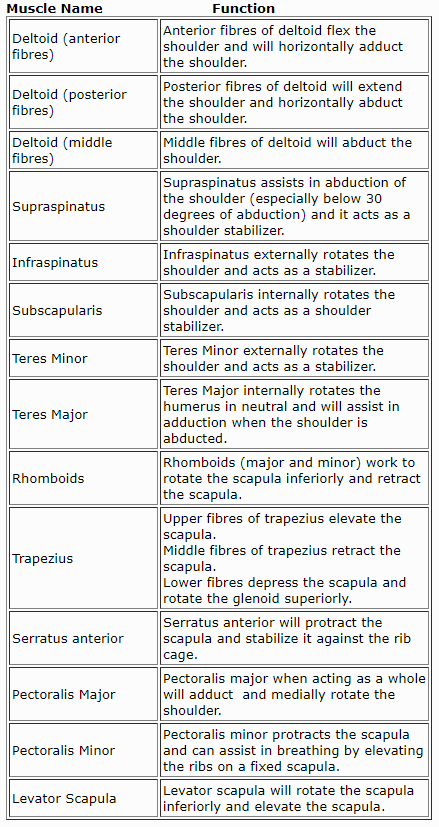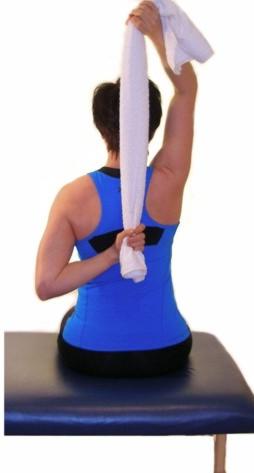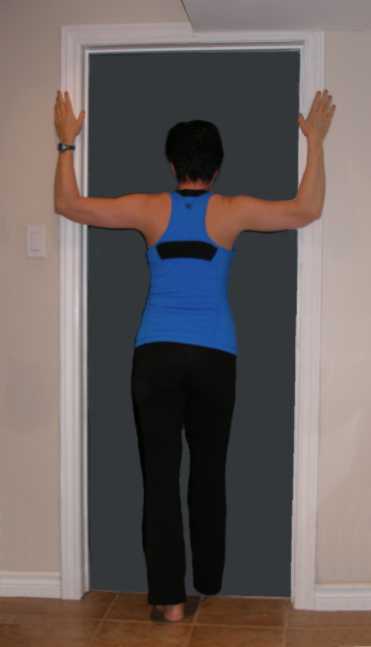Shoulder Stretches
Shoulder stretches are necessary to maintain a balance among the muscles around the shoulders and upper back. As gravity pulls us forward and things in our life that demand our attention pull us forward, the muscles on the front of our chest and shoulders shorten. These forces cause disc degeneration, head and neck pain, rotator cuff impingement, amongst other problems. Regular shoulder stretches can improve posture, improve function, and make us feel and look younger. For a lot of us stress in our lives is manifested by tightness and hyperactivity of our shoulder muscles.
Contents
What are the muscles of the shoulder?
What is the Rotator Cuff?
What is the function of the Rotator Cuff?
What are we stretching when we stretch the shoulder?
Dangers of over stretching the shoulder.
What is the pendulum exercise.
Shoulder Stretches
What are the muscles of the shoulder?



What is the Rotator Cuff?
The rotator cuff consists of four muscles and their tendinous attachments to the humerus:
- Supraspinatus
- Infraspinatus
- Teres Minor
- Subscapularis
Shoulder stretches often need to target the rotator cuff.

What is the Function of the Rotator Cuff?
As you can see on the diagram the rotator cuff will function to rotate the humerus medially (subscapularis) and laterally (infraspinatus, teres minor) and through abduction (supraspinatus). Functionally they are relatively insignificant rotators compared to the more superficial muscles. The force vector angles are much too close the the joint resulting in a poor moment arm to cause rotation.
The supraspinatus is insignificant as an abductor compared to the deltoid. The supraspinatus force-vector angle is too close the the joint to create a strong abduction torque. It can be appreciated that the function of the supraspinatus is to pull the humerus into the glenoid to create stability during shoulder movements.
Similarly, the infraspinatus and teres minor can act as lateral rotators and the subscapularis can act as a medial rotator, but due to the proximity of the force-vector to the joint line this is very ineffective. Hence, they function more as joint stabilizers.

What are we stretching when we stretch the shoulder?
The shoulder is held together by the dynamic stabilizers (muscles) and the static stabilizers (ligaments and joint capsule).
The danger in doing shoulder stretches is that we overstretch the static stabilizers. Over stretching the glenohumeral ligaments and anterior joint capsule leads to excessive translation of the humeral head anteriorly which can cause inpingement. Unfortunately many arm and shoulder stretches focus on stretching in the direction that can overstretch theses structures. For this reason it is important not to bounce into these stretches or apply excessive force.
Dangers of Over Stretching the Shoulder
The shoulder is a very shallow joint. It is because of this that we have a very large range of motion. Reaching up 180 degrees, reaching behind the back, reaching around the side is all possible because of the structure of the shoulder joint. The shoulder depends on activity in the rotator cuff musculature and adequate support form ligaments for stability.
The biggest danger of over stretching is instability of the shoulder. Instability of the shoulder can lead to
- Tendinitis/bursitis
- Tendonosis
- Rotator cuff tears
- Impingement syndrome
- Labral damage
- Arthritis
Shoulder instability is the result of loss of the ability to control the head of the humerus in the glenoid fossa during activity. Normal function of the shoulder is a balance between adequate mobility and stability. If you suffer from any of the above conditions it may be due to instability. You will require a thorough assessment from a physical therapist to determine such. Stay away from doing shoulder stretches until you see a professional.
What is the pendulum exercise?
The pendulum exercise is not a shoulder stretch. It is an exercise prescribed to help maintain mobility, relax the shoulder muscles, and by stimulating nerve endings within the joint helps block pain.
Shoulder Stretches
Levator Scapula
- Sit up straight on a chair
- Put your hand up over your shoulder and bring your elbow back, pointing your elbow up to the ceiling
- Use your left hand to pull your head forward and to the left.
- Hold this position for the appropriate time

Upper Fibres of Trapezius
- Sit upright on the edge of a chair and hold onto the chair with your right hand.
- Turn your head to the right
- Use your left hand to pull your head straight to the left
- To feel more stretch, lean your body slightly to the left to depress your right shoulder further.

Supraspinatus
The
supraspinatus abducts and externally rotates the shoulder therefore
stretching must involve adduction and internal rotation.
- Throw a towel over your left shoulder
- Grab the towel behind your back with your right hand
- Pull the towel and hence your hand up your back while keeping your right shoulder relaxed and your hand over on the left side of your back
Hold this position for the appropriate time

Infraspinatus, Teres Minor, Rhomboids, Middle Trapezius
- While sitting on a chair raise your arm and pull your elbow across your chest to bring your scapula further from your spine.
- Hold this position for the appropriate time

Latissimus Dorsi, Teres Major
- Stand with feet shoulder width apart, chest up and head back over your shoulders.
- Raise the right arm over head and grab your right elbow with the left hand.
- Pull your right elbow over to the left gently and bend your trunk to the left until a comfortable stretch is felt.
- Hold this for 30 - 60 seconds.
- Repeat this on the other side.

Pectoralis major, Anterior Joint Capsule
Because the fibres of this muscle lie in different directions, it is best to hit it from different angles.
- Stand in a doorway with shoulders and elbows at 90 degrees, hands clasping the door frame to stretch the horizontal fibres and those originating from the clavicle
- Take a step in through the door and hold this
- Raise your hands further up the door frame to hit the lower sternal fibres and that part of the muscle that originates lower on the chest
Hold this position for the appropriate time

Pectoralis Minor
- Lie on your back with knees bent.
- Keep your arms comfortable at your sides .
- Actively pull your shoulder blades together and feel your shoulders flatten toward the floor.
- Try and pull your shoulder blades down toward your feet as well.
- Hold this.
- Bring your elbows out from your sides and let your hands fall back with your elbows at 90 degrees.
- Again, pull your shoulder blades down and back to bring your shoulders closer toward the floor.
- Hold this stretch for the appropriate time.

Posterior Joint Capsule
- Lie on your right side on your right shoulder.
- Position your right shoulder in approximately 30 degrees of flexion (your elbow should be about a third of the way up to shoulder level).
- Bend your elbow to 90 degrees such that your hand is pointing toward the ceiling.
- Grab your right forearm and bring your hand down toward the floor.
- Be gentle and repeat after holding for the appropriate time.
Posterior joint capsule tightness is often a cause of an anteriorly situated humeral head. This can cause subacromial impingement, tendinitis and bursitis. While maintaining posterior capsule flexibility is important, one must take care not to over stretch the joint capsule. If you think you have capsular tightness rather than do all the shoulder stretches you can find, it is best to seek the advice of a physical therapist who can evaluate joint mobility and use manual techniques if necessary to address such dysfunctions.
Biceps Brachii (long head)
- Stand with your right side facing a wall
- Place your hand on the wall at shoulder height with elbow straight and thumb pointing down
- Turn your body away from the wall and maintain the rotation of your arm
Hold this position for the appropriate time
